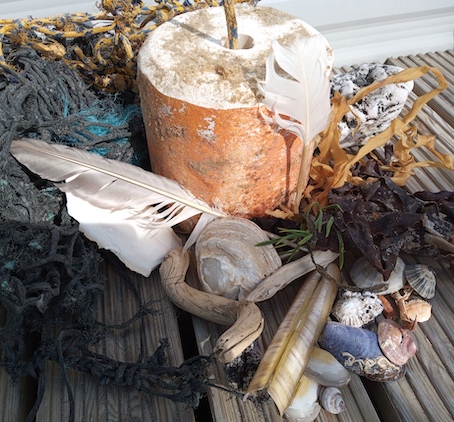
Where the sea meets the land all sorts of treasures can be washed up, and collecting some of these will fascinate children and adults alike. All you really need are a bag (a backpack is especially useful) or bucket and sharp eyes. If you take a bag for litter too, then you can also fulfill a useful social function, and teach children to look after the environment, by performing a mini beach clean - especially removing items which may be dangerous to wildlife such as plastic carrier bags. Depending on the nature of the beach, you might want to take a net (useful in rock pools) or a trowel with which to dig up creatures which may live under the surface of sand or mud. Obviously you should be aware of the tide, which can roll in very quickly on flat beaches, and avoid any danger of being overtaken or cut off by it.
Here are some of the things you might find:
- Shells - some have beautiful colours and patterning, some may be damaged, showing their internal structure, some may be encrusted with barnacles.
- Pebbles - small pieces of rock, often smoothed into wonderfully tactile rounded shapes by the grinding action of the sea. You may also find "sea glass" pieces of glass (often brightly coloured) smoothed into gems by the sea.
- Driftwood - there is a special quality to wood which has been smoothed and bleached by the sea.
- Seaweed - bladder wrack, with its distinctive bubbles (which cause the fonds to float upward in the water) is especially common, but there are many other types.
- Egg cases from dogfish, rays and sharks ("mermaid's purses") or from dog whelks (looking rather like dried-up sponges) and other creatures.
- Crab shells, cuttlefish bones, sea urchin skeletons.
- Bird feathers.
- Rubbish discarded or lost by people, including fishermen. Some of this can be quite interesting, but of course much of it is a hazard for wildlife.
- Live molluscs (mussels, limpets, winkles, whelks etc) crabs and shrimps, as well as starfish and jellyfish which may have become stranded.
- Worm casts - a sign of life beneath the sand.
- Tracks in sand or mud - of birds and worms, as well as dogs and people.
If you want help identifying some of the things you may find, there are some web sites which may help - for example this one from the Lincolnshire wildlife trust - and there are some excellent books, such as "The Essential Guide to Beachcombing and the Strandline" by Trewhella and Hatcher, which will give much more information.
What to do with the material scavenged from the beach? Live creatures should be replaced where they were found after taking a good look at them, and possibly making a drawing or taking a photo. However, non-living items can be used in many ways. For example, they could be used to assemble a "sea picture", on the beach, or taken home for display on a nature table, to make a small "sea garden" or stuck on card to make a collage.